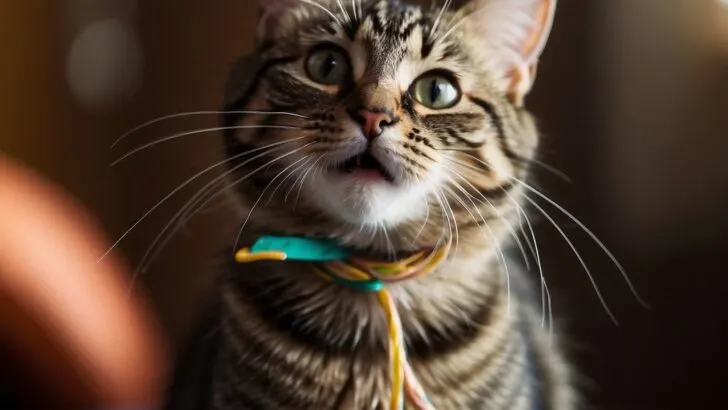Cats often find rubber bands irresistible due to their innate hunting instincts. When you observe your feline friend playing with a rubber band, they may be drawn to the way it mimics the movement of prey – the stretchiness and unpredictability of the rubber band’s movements pique a cat’s interest similarly to how a mouse or bird might dart away.
In my experience, I’ve watched cats bat and pounce on rubber bands with the same focus and determination they would exhibit while stalking a small creature in the wild.

These seemingly simple household items can provide your cat with a variety of play options. Cats enjoy the tactile sensation of the rubber and may chew on it, stretch it, or flip it into the air. This provides both sensory stimulation and a physical outlet for their energy.
For instance, my cat often keeps himself entertained by stretching rubber bands between her paws, honing his hunting skills even when indoors.
Beyond their playful aspects, the interaction with rubber bands also serves a practical purpose from your cat’s perspective. Such objects can be batted around and chased without the need for human interaction, allowing cats to engage in independent play.
This not only offers them exercise but also satisfies their need for self-amusement when you’re not around to play with them. Keep in mind, though, that playing with rubber bands should always be supervised to ensure they don’t swallow small pieces or the entire band, as it can cause choking or internal blockages.
Understanding Cats’ Attraction to Rubber Bands

Cats’ fascination with rubber bands involves a complex mix of sensory experiences and natural behaviors.
The Role of Texture and Scent in Cats’ Fascination
Rubber bands have a unique texture that mimics the feel of prey for cats. This chewy texture coupled with the distinct scent can be irresistible, as cats rely heavily on texture and smell for exploration and identification.
Hunting Instincts and Playful Behaviors
Your cat’s hunting instinct is stimulated when playing with rubber bands. Their prey drive kicks in, making rubber bands an excellent tool for honing their hunting skills while mimicking the thrill of the chase during playtime.
The Sounds and Movements of Rubber Bands
The twang and vibrations produced by snapping rubber bands are akin to the sounds of scurrying prey, keeping your cat entertained and engaged. The unpredictable movement stimulates their predatory behavior.
Psychological Effects: Stress Relief and Mental Stimulation
Engaging with rubber bands can help your cat self-soothe against stress and anxiety, providing essential mental stimulation to stave off boredom.
Rubber Bands Compared to Other Feline Toys
While rubber bands are attractive, they aren’t always safe. Interactive toys or wand toys are safer alternatives that equally fulfill a cat’s need for physical and mental activity without the risks.
Health and Safety Considerations for Cats and Rubber Bands
Rubber bands can be fatal if swallowed, leading to intestinal blockage and other health complications. Always ensure they are kept out of reach and provide size-appropriate, safe cat toys instead.
Potential Behavioral Issues and Obsessions
Some cats may develop an obsession or destructive behavior like hoarding or pica—the urge to eat non-edible items. Monitor your cat to avoid these excessive behaviors.
Exploration and Tactile Experience: Why Interaction Matters
Cats love to explore their environment. The tactile experience of rubber bands adds a layer of stimulation that can enhance their natural tactile sensation and satisfy their curiosity through activity.

My name is James, and welcome to FAQCats!
Along with our team of cat owners, expert pet enthusiasts, and pet professionals, we aim to write engaging helpful, engaging content about cats. At FAQCats we strive to provide content that’s accurate and fun to read. Our team writes about everything related to cats; even the most complex of topics. Through extensive research and caring for our own fur-pals, we’re able to provide something cat owners worldwide will love. Have a look around, and leave us feedback anytime!

